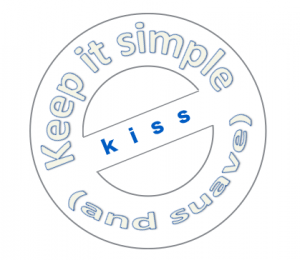From a user’s perspective, few are the sites or apps that provide a truly exceptional user experience. There are many reasons for this.
Why is the user experience so poor?
 Trying to please all people
Trying to please all people- The underlying architecture is out-dated
- The navigation is confusing
- The images are too heavy and the site doesn’t load quickly
- The website has been constructed by multiple people from multiple departments over a prolonged time
- Allocated resources were not sufficient
- The team is lacking the requisite skills
- The mobile version is nonexistent
- and it goes on…
I marvel at how some sites are structured. You can still find sites that are set up merely according to the organization’s structure, with internal department titles lining the navigation tabs. Even worse, in-house jargon appears on the customer-facing website. How is the customer supposed to find satisfaction in such an environment?
Is your video aligned with your audio?
Well before tackling the design of a website or a mobile interface, a brand must come to terms with its overall purpose and business objectives. That is easier said than done. In many instances, I have observed how the company’s purpose can be disjointed and unclear throughout the organization. Worse, the company’s actions are in contradiction to its stated intentions. For example: take brand x that describes itself as being “customer centric.” Its employees would be right to ponder how is it that the brand’s customer service is outsourced? Why is there never discussion internally about customer satisfaction or customer-focused KPIs? When a customer gives ad hoc oral feedback or fills in a survey, to what extent is that feedback ever taken into account? Why is the year-end interview only about sales, management issues and career evolution? As Robin Sharma says:
Make sure your video is aligned with your audio! {Tweet this!}
Keep it simple, stupid…
In the spirit of Design maven, Jony Ive (@Apple), it’s all about keeping the user interface simple. But, that is not easy to accomplish, especially when you have millions of customers with whom to deal, much less multiple stakeholders inside the company. Creating a design or user interface that works magnificently for everyone is just not feasible. A great user experience is inevitably the result of tough decision-making. The objective is to make the interface so intuitive that even a kid could find its way around. To wit, Apple’s devices come without an instruction manual.
Customer experience – a state of mind
In order for an organization to get the customer experience right, management needs to be the first to carry the “customer flag” and defend the customer’s point of view. Secondly, a truly customer-centric organization must orient its business workflow around the customer. In this regard, it is invaluable to observe customer behavior in the most natural (aka real) situations. Moreover, when doing user observation labs, I like to recommend having all the key decision-makers observing the customer behavior together. In this manner, the argument (between internal parties) is centralised around the customer experience. In the end of the day, getting the customer experience right is a state of mind, requiring some hard decision-making and strategic choices. Keeping it simple is easy to say (or write); but, in reality, the elegance of a simple solution is rarely an easy thing to achieve.
3 keys to creating a great user experience (top line)
- The Customer Journey. Empathy is a significantly important quality in understanding the customer journey. It is only truly possible to create a great user experience once you accept to get into the shoes of your customer. The key point is to understand fully the customer’s context at the time of contact. One of the cardinal sins of ‘traditional’ marketers is to do observation sessions of customers surfing in sterile conditions, based on a marketing script. An important part of creating a superior customer experience comes from understanding the customer’s situation at the time of interface (bandwidth, device, surroundings, time to spare, mindset…).
- Breaking down silos. Most companies have a legacy structure that perpetuates silo-building. For digital activities, the isolation can be catastrophic. I have seen many cases where web marketing teams are segregated from the rest of the business. In any event, that is too often how websites or apps are created: in virtual isolation from the remainder of the business. In creating a great customer experience, many people in the business beyond marketing need to be included such as IT, sales/retail and customer service. I would further counsel, at least at the beginning, having a much wider net, including the CEO, HR Director (for better appreciation of the skillset required) and even the Finance Director. The point of having all members of the team participate in observation sessions (e.g. behind a one-way mirror) is to have the internal debate focused around the customers’ experience. This way, conversations move from “I don’t have the resources” or “I can’t do that” to “how can we improve what we just witnessed?”
- Aesthetics count and… it needs to work. Since technologies and usages are in constant flux, what constitutes a great user experience is also in movement. In order to get the user experience right, you clearly need to have the right talent. Taste and refinement are intangible qualities, but it’s all about the right attitude: to obsess about the look, the feel, the functionality, the navigation.{Tweet this!} Importantly, the individuals need to be curious and open to continuous learning, unlearning and relearning.{Tweet this!} If aesthetics are intimately related to brand image, functionality is related to simplicity. The challenge is to marry aesthetics with practical functionality.
To create an optimal customer journey is like engaging in a complex and long experiment. Not only are there different customer profiles, there are scores of channels, platforms and devices to select before considering the appropriate timing and content. Digital is marvellous in that it allows for metrics that most executives would dream about. Unfortunately, few top executives have the measure of the options and data that digital affords.
When the conversation about building and designing a website or mobile app is oriented and focused around observations of a (real) customer’s experience, the internal silos and legacy problems are viewed with a different light. Nothing evaporates overnight, but at least the debate is organized around the person who is, ultimately, paying the bills and spreading the word: i.e. the consumer.
Happy to hear your reactions!













Nice!